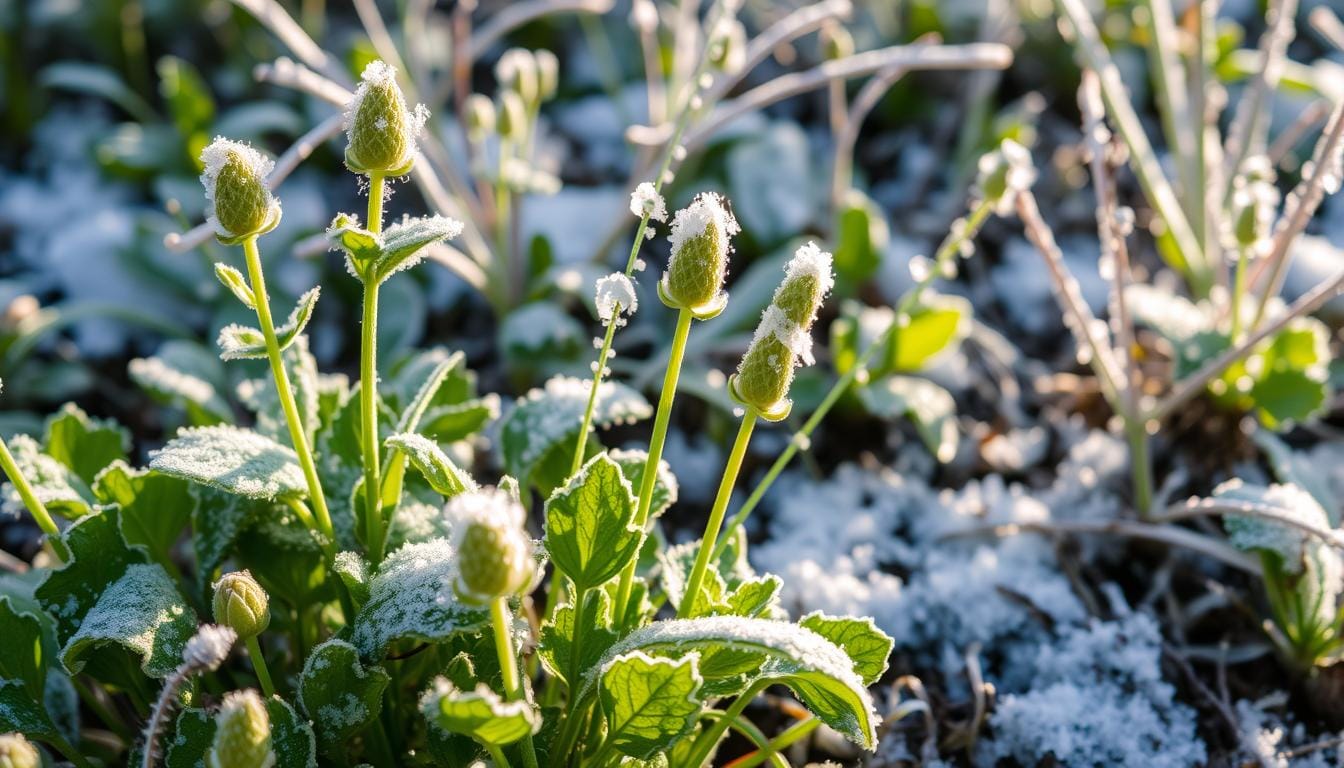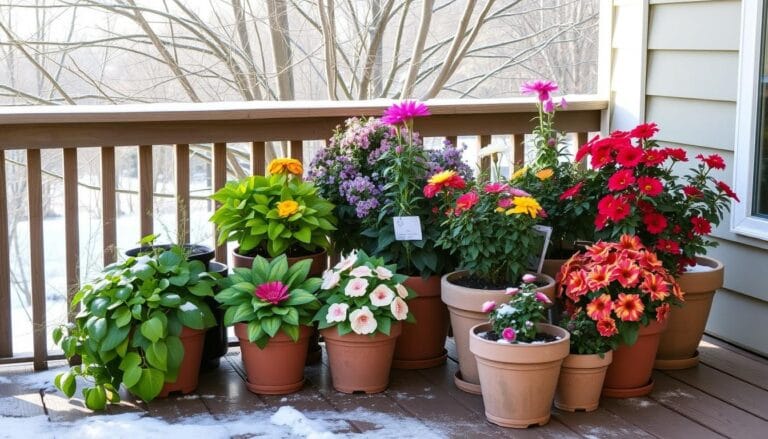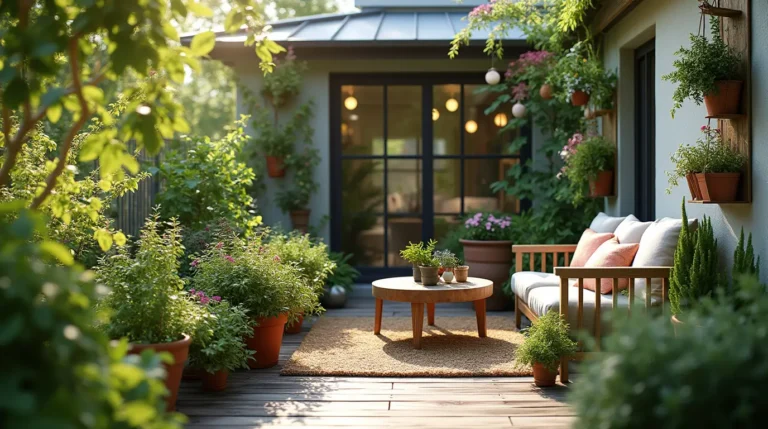Why Herbaceous Plants Die Back Each Winter: A Guide

As autumn arrives, your herbaceous plants may start to fade. This is a natural process that happens every year. It’s a dance between plants and nature.
Herbaceous perennials, like many garden favorites, go dormant each year. They shed their leaves and stems to survive the cold.
This cycle shows how tough and adaptable these plants are. It might look like they’re dying, but they’re actually saving energy for spring. Let’s dive into why this happens and how plants come back strong every year.
Table of Contents
Understanding Herbaceous Plants and Their Nature
Herbaceous plants are a wide range of plants that grow in gardens. They include annuals, biennials, and perennials. These plants have soft stems that die back to the ground each winter. They come back in the spring.
Knowing about herbaceous plants helps make gardens full of life and color.
Definition and Key Characteristics
Herbaceous plants have green, flexible stems and don’t grow woody. They are the main food crops and many garden plants. Their growth above ground dies back each fall, but roots and underground parts survive winter.
Common Types of Herbaceous Plants
- Annual plants live for just one growing season, dying after they set seed.
- Biennial plants need two years to mature. They grow leaves and stems the first year and flowers and seeds the second.
- Perennial plants live for many years. Their stems and leaves die back each winter but grow again from underground in spring.
Role in Garden Ecosystems
Herbaceous plants are vital in gardens. They offer food and shelter for many animals, like pollinators and birds. Their leaves and flowers add beauty to gardens all season.
“Herbaceous plants are the dominant vegetation in many ecosystems like grasslands, bogs, and marshes, and they contribute to the understory biodiversity in forests.”
Why Herbaceous Plants Usually Die Back to the Ground Each Winter
When winter comes, you might see your favorite herbaceous plants start to fade. This isn’t a sign of failure. It’s a clever way they survive the cold. The winter dormancy is a key part of their life cycle, helping them adapt to cold weather.
Herbaceous plants, like perennials and some annuals, die back to the ground in winter. This helps them save energy and protect their roots, bulbs, and rhizomes from the cold. By focusing on these underground parts, they can “hibernate” until spring.
This strategy is vital for these plants to grow well in areas with clear seasons. When it’s too cold to grow, they go dormant. This lets them stay strong until spring, when they can grow and bloom again.
| Plant Type | Life Cycle | Survival Strategy |
|---|---|---|
| Annual Plants | Complete their life cycle within one year | Die completely, relying on seeds to regenerate |
| Perennial Plants | Survive for more than one growing season | Die back to the ground, with roots, bulbs, or rhizomes remaining alive underground |
| Biennial Plants | Take two years to complete their life cycle | Produce foliage in the first year, bloom and set seed in the second year, then die |
Understanding why herbaceous plants die back helps us see their amazing survival tactics. This natural cycle is crucial for their growth in different climates. It lets them keep our gardens beautiful year after year.
The Science Behind Winter Die-Back Process
As winter comes, herbaceous plants change in a way that helps them survive the cold. This die-back process involves changes at the cellular level. It helps these plants protect themselves from freezing temperatures.
Cellular Changes During Cold Weather
Herbaceous plants adjust at the cellular level during cold hardiness. They make proteins that act as antifreeze, lowering the freezing point of their fluids. They also increase sugars and other substances to better withstand the cold.
Energy Conservation Mechanisms
To save energy, these plants focus on their roots during the dormant period. They move nutrients and carbohydrates to their roots and other storage areas. This ensures they have energy for growth when spring comes.
Root System Survival Strategies
The root system is key in the die-back process. Roots use tactics like antifreeze proteins and sugars to stay alive. This lets them support the plant’s growth when it gets warmer.
The die-back process in herbaceous plants is amazing. By understanding this, gardeners can better care for their plants. This leads to a healthier garden ecosystem.
Survival Mechanisms of Herbaceous Perennials
Herbaceous perennials are the colorful plants that make our gardens lively year-round. They have clever ways to survive the cold winter. These tricks help them stay alive and grow strong when spring comes.
One key trick is their thick, insulating bark on roots. This layer keeps the roots warm and safe from freezing. It helps the plant stay healthy and strong.
Another clever trick is making antifreeze in their cells. This natural defense keeps the plant’s fluids from freezing. It lets them stay alive even when it’s very cold.
Many perennials also save energy in their roots. They store food like starch or carbs in bulbs or tubers. This food helps them grow again when it’s time.
Some plants, like Helleborus and Polystichum, keep their leaves all winter. This lets them keep growing and getting nutrients. It gives them a jumpstart in the spring.
Others, like ornamental grasses, keep their dried leaves and seeds. This makes them look good in winter. It also protects their roots from the cold.
These survival tricks show how smart and tough herbaceous perennials are. They use many ways to stay alive and beautiful in our gardens. They make our gardens lively and interesting all year.
| Adaptation | Description | Benefits |
|---|---|---|
| Thick, insulating bark on roots | Protective layer that shields underground structures from freezing temperatures | Prevents freeze damage and ensures the plant’s vital systems remain intact |
| Antifreeze compounds in plant cells | Specialized chemicals that lower the freezing point of the plant’s fluids | Allows the plant to withstand sub-zero temperatures without cell damage |
| Energy storage in underground structures | Reserves of starch or carbohydrates stored in bulbs, tubers, or rhizomes | Provides the necessary fuel for the plant to regenerate growth in spring |
| Evergreen foliage | Maintenance of a protective covering of leaves throughout the winter | Allows for continued photosynthesis and nutrient access, giving the plant a head start in the new growing season |
| Dried foliage and seedheads | Retention of withered above-ground structures during winter | Provides winter interest and protects the plant’s crown from harsh conditions |
These survival tricks show how smart and tough herbaceous perennials are. They use many ways to stay alive and beautiful in our gardens. They make our gardens lively and interesting all year.

Underground Storage Systems and Their Functions
Herbaceous plants have special underground systems to survive winter. These systems, like bulbs and tubers, keep the plants’ energy and nutrients safe. This way, the plants can grow strong again when spring comes.
Bulbs and Tubers
Bulbs, found in daffodils and tulips, store nutrients in their scales. They act as the plant’s winter food, helping it grow again in spring. Tubers, like those in dahlias, also store important nutrients underground.
Rhizomes and Corms
Rhizomes are underground stems in plants like iris and ginger. They store energy and grow new shoots, helping the plant spread. Corms, similar to bulbs, are also key for storing underground nutrients.
Root Crown Protection
The root crown is at the plant’s base and is well-protected. It’s surrounded by plant storage organs and soil. This keeps the plant’s winter reserves safe, ready for growth when spring arrives.
These underground systems are vital for herbaceous plants to survive winter. They help the plants come back stronger in the spring.
Seasonal Growth Cycle and Dormancy Period
Herbaceous plants go through big changes with the seasons. In spring and summer, they grow fast, making leaves, flowers, and seeds. But when fall comes, with cooler weather and less daylight, they slow down to survive the cold winter.
This slowdown is a natural way for plants to rest and get ready for spring. As it gets colder, plants change inside to protect themselves from freezing. Their roots and underground parts help them stay alive during this time.
The length of this rest period varies by plant and where it grows. In places like Washington state, plants face huge changes in daylight. This big change tells the plant it’s time to rest until the weather gets better.
Knowing how plants grow and rest is key for gardening and controlling weeds. Gardeners can use this knowledge to work smarter, not harder. They can choose the right time to fight weeds, using methods that work best when plants are active or dormant.

“Dormancy is a seasonal occurrence triggered by winter temperatures in plants, leading to a protective rest period against extreme conditions like freezing temperatures or drought.”
Winter Protection Strategies for Herbaceous Plants
As winter approaches, it’s vital to protect your herbaceous plants. A few strategies can help your garden stay healthy through the cold months. This way, it will bloom beautifully in the spring.
Mulching Techniques
Mulching is key to keeping your plants safe in winter. Use a 1- to 2-inch layer of organic mulch like straw or leaves. This keeps the soil warm and protects the roots from freezing.
Soil Preparation Methods
Good soil is essential for winter survival. Make sure your beds drain well to avoid waterlogging. Adding compost can also help your plants stay strong through the winter.
Timing of Winter Protection
When you start protecting your plants is important. Wait until the ground is frozen to mulch. This stops plants from getting too warm. Also, water deeply before the ground freezes to keep your plants moist.
With these strategies, your plants will thrive through winter. Remember, planning and timing are crucial for a successful garden.
“Preparing your garden for winter is just as important as tending to it during the growing season. A little effort now can make all the difference in how your plants fare in the months ahead.”
Spring Recovery and Regeneration Process
When winter ends, herbaceous plants start to come back to life. They use the stored energy to grow new shoots and leaves. This is a beautiful sight as the weather gets warmer and days longer.
The plant regeneration in spring takes time. Each plant grows at its own pace. But they all share the goal of spring growth and starting anew.
As they grow, these plants start making food again. This food will help them survive the next year. Their ability to rest and then grow again shows how strong they are.
“The coming of spring is a time of renewed hope and boundless possibilities for the plant kingdom. With each unfurling leaf and budding flower, we witness the cycle of life in action.”
Watching our gardens come alive in spring is amazing. It shows us how incredible these plants are. They are truly resilient and full of life.
| Key Aspects of Spring Regeneration | Description |
|---|---|
| Dormancy Breakage | As temperatures rise and daylight increases, herbaceous plants emerge from their winter dormancy, drawing on stored energy reserves. |
| Shoot and Leaf Production | The plants begin to produce new shoots and leaves, gradually rebuilding their aboveground structures. |
| Photosynthesis Resumes | With the return of green foliage, the plants resume the critical process of photosynthesis, replenishing their energy stores. |
| Cyclical Adaptation | The spring regeneration process is part of the plants’ inherent adaptation to the changing seasons, ensuring their long-term survival. |
Common Herbaceous Plants in American Gardens
American gardens are filled with a variety of herbaceous plants. These plants add beauty and life to gardens across the country. They come in different colors, textures, and bloom times.
The coneflower (Echinacea) is a standout native plant. It has vibrant purple blooms and attracts bees and butterflies. Another favorite is the black-eyed susan (Rudbeckia), known for its yellow flowers and strong growth.
Non-native plants like daylilies (Hemerocallis) and hostas are also popular. Daylilies come in many colors and bloom at different times. Hostas are loved for their lush, shade-loving leaves.
Peonies are known for their large, fragrant blooms. They thrive in many areas. Ornamental grasses, such as switchgrass (Panicum virgatum) and little bluestem (Schizachyrium scoparium), add texture and movement.
There’s a growing trend to use more American native plants in gardens. Plants like Joe-Pye weed (Eupatorium) and bee balm (Monarda) are becoming more popular. They are adaptable, resilient, and good for local ecosystems.
Whether you like bold colors, graceful grasses, or easy-to-care-for plants, there’s something for everyone. American gardens can be vibrant and dynamic with the right herbaceous plants.
| Native Herbaceous Plants | Non-Native Herbaceous Plants |
|---|---|
|
|
By mixing native and popular herbaceous plants, American gardeners can create beautiful, easy-to-care-for gardens. These gardens are good for the environment and look great all season.
Managing Herbaceous Plants Through Seasons
Caring for your herbaceous plants all year is key to their health and long life in your garden. Each season needs special care to help your plants grow well.
In the spring, start by removing winter mulch and pruning dead or damaged leaves. This lets your plants start fresh and grow well. Also, divide crowded plants to make them strong again.
- Prune dead or damaged foliage at the base of the plant
- Remove winter mulch to allow new growth to flourish
- Divide overcrowded clumps of herbaceous plants
In the summer, keep the soil moist, fertilize regularly, and remove spent flowers. This helps your plants bloom more and grow strong.
- Water plants regularly to keep soil consistently moist
- Apply a balanced fertilizer to support vigorous growth
- Deadhead spent flowers to prolong the blooming period
When fall comes, get your plants ready for winter. Cut back old leaves, divide crowded plants, and mulch to protect roots and crowns.
In the winter, you don’t need to do much. Just check your plants for damage and protect them with mulch or frost blankets if it’s very cold.
By following these seasonal care tips, your herbaceous plants will thrive. They’ll add vibrant beauty to your garden all year.
Conclusion
Knowing how herbaceous plants work is key to good gardening in the U.S. Understanding their winter die-back helps you care for them all year. This care keeps your plants healthy and long-lasting.
This knowledge helps you grow diverse, strong landscapes. These landscapes are beautiful, good for the environment, and easy to care for. Whether you’re growing flowers, perennials, or veggies, knowing what your plants need in winter is crucial.
By following the natural growth and rest cycles of plants, your garden stays vibrant. You’ll see beautiful flowers in spring and rich mulch in winter. With the right care, your garden will keep growing, year after year.
FAQ
What are herbaceous plants and how do they differ from woody plants?
Why do herbaceous plants usually die back to the ground each winter?
How do herbaceous plants adapt to survive the winter?
What are the key stages of the seasonal growth cycle for herbaceous plants?
How can gardeners provide proper winter protection for herbaceous plants?
What are some common herbaceous plants found in American gardens?
How can gardeners manage herbaceous plants effectively throughout the seasons?
Source Links
- Ever Wondered What a Herbaceous Plant Actually Is? We Have Answers – https://www.thespruce.com/what-are-herbaceous-plants-2131063
- Complete guide to perennials – https://www.gardenersworld.com/how-to/grow-plants/20-best-perennial-plants/
- What do the terms perennial, biennial and annual mean? David Domoney – https://www.daviddomoney.com/perennial-definition-biennial-meaning/
- Herbaceous plant | Definition, Examples, Structure, Ecology, Importance, & Facts | Britannica – https://www.britannica.com/plant/herbaceous-plant
- Perennials | University of Maryland Extension – https://extension.umd.edu/resource/perennials
- Annual, Perennial, Biennial, Ephemeral: Explaining Common Garden Terms – https://www.epicgardening.com/annual-perennial-biennial-ephemeral/
- What’s the Difference Between an Annual and a Perennial Plant? – https://www.bhg.com/gardening/flowers/perennials/difference-between-annual-and-perennial-plants/
- Plant types explained — Victoria Wade – https://www.victoriawade.co.uk/blog/plant-types-explained
- What a warmer winter means for your garden – https://planetdetroit.org/2024/03/warmer-winter-affects-plants/
- Climate change is shifting the zones where plants grow • North Dakota Monitor – https://northdakotamonitor.com/2024/04/29/climate-change-is-shifting-the-zones-where-plants-grow/
- Environmental factors affecting plant growth – https://extension.oregonstate.edu/gardening/techniques/environmental-factors-affecting-plant-growth
- Growing old while staying young: The unique mechanisms that defy aging in plants – https://pmc.ncbi.nlm.nih.gov/articles/PMC10933334/
- Manage Weeds Without Chemicals in Maryland – https://extension.umd.edu/resource/manage-weeds-without-chemicals-maryland
- 7 Steps to Build a Forest Garden for Wildlife – https://www.thrivelot.com/resources/7-steps-to-build-a-forest-garden-for-wildlife
- Chill Out! Mastering Frost Protection for Your Plants – https://horticulture.co.uk/how-to-protect-plants-from-frost/
- How Do Plants Survive The Fall? Evolution! – Agway of Cape Cod – https://agwaycapecod.com/evolution-of-plants-in-the-fall/
- What is Plant Dormancy & Why Does it Matter? – https://kingcountyweeds.com/2023/12/20/what-is-plant-dormancy-amp-why-does-it-matter/
- 5 Tips for Winterizing Your Perennial Plants – https://www.bhg.com/gardening/flowers/perennials/preparing-perennials-for-winter/
- 10 Tips from the Pros: Preparing Your Garden for Winter | The Morton Arboretum – https://mortonarb.org/blog/10-tips-from-the-pros-to-prepare-your-garden-for-winter/
- Flowering in the Northern Hemisphere is delayed by frost after leaf-out – Nature Communications – https://www.nature.com/articles/s41467-024-53382-3
- Potential processes leading to winter reddening of young Douglas-fir Pseudotsuga menziesii Mirb. Franco. in Europe – Annals of Forest Science – https://annforsci.biomedcentral.com/articles/10.1186/s13595-024-01242-x
- Perennial Garden | Sutherlands Blog – https://sutherlands.com/blog/garden/perennial-garden/277?srsltid=AfmBOorFIk7he_sUhuMncoWhbE2CLG2G_y5eUZXC4ggG0n3vO6KWv5Nv
- Keeping Perennials Healthy All Year – Urban Extension – https://www.aces.edu/blog/topics/lawn-garden-urban/keeping-perennials-healthy-all-year/
- How to cut back herbaceous perennials – https://www.gardenersworld.com/plants/how-to-cut-back-herbaceous-perennials/
- Evergreen Perennials: The Greening of Winter – https://extension.psu.edu/evergreen-perennials-the-greening-of-winter
- How to Cut Back Perennials in Fall – https://www.almanac.com/how-cut-back-perennials-fall
- Plant development – Senescence, Aging, Growth | Britannica – https://www.britannica.com/science/plant-development/Senescence-in-plants
- Should You Pull Up Annuals or Leave Them to Decompose in the Garden? – https://www.epicgardening.com/pull-up-or-leave-annuals/
There are no reviews yet. Be the first one to write one.






